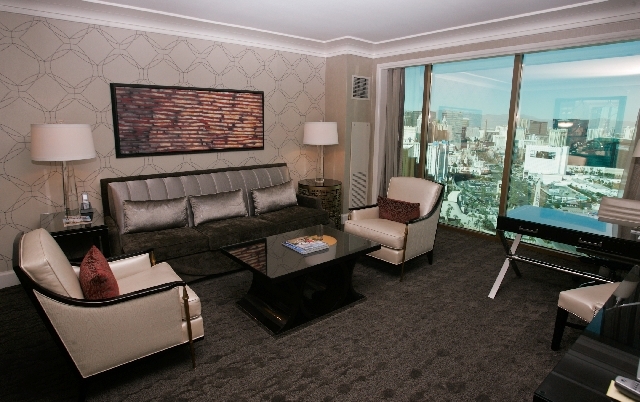Split personalities
To carry the “boutique” descriptor in any field suggests an element of success, that something is small but selective, quality wins out over quantity, and exclusivity is the priority. Boutique hotels have increased in popularity over the past decade. So in a city known for a bigger-is-better approach, there has been an emphasis on creating that intimate experience among the giant brands that make Las Vegas an internationally known destination. As a result, boutique hotel offerings imbedded within mega resorts are thriving.
In 1999, the Four Seasons opened, quietly tucking itself into the 35th through 39th floors of the Mandalay Bay . All the grand opening festivities, which included Hollywood stars riding Harley’s through Mandalay Bay’s front doors, were centered on the 3,300-room mega property. And there was little said of the Four Seasons niche offering — which many gaming experts point to as the start of Las Vegas’ imbedded boutique hotel concept — that would bring discerning travelers who want access to the big-time gaming and entertainment of Las Vegas, but also a retreat into space that shows little resemblance.
“Twenty years ago people didn’t expect great hotels. They just wanted a room. In the past decade we’ve become less of a gaming destination. Las Vegas is now a place where the nongamer is equally comfortable,” said Lezlie Young, vice president of SkyLofts and The Mansion at MGM Grand.
Major resort companies such as MGM Resorts International and Caesars Entertainment aren’t about to ditch their huge several thousand room mainstay hotels. But in the world of the less gaming-focused traveler, they appear to be leveraging the big attractions and names to find smaller pockets of higher-spending travelers who demand that “boutique” exclusivity.
At the MGM Grand, in a separate entryway near the massive hotel’s front desk, is an easily overlooked small marbled alcove. This double-door entrance to the SkyLofts reception area leaves the loud bustling Strip life behind once the doors close behind you. Imagine that: Guests can have conversations without shouting, and a casino floor is less than 50 feet away.
A quick elevator ride to the 39th floor brings the real SkyLofts experience. After the elevator doors open, a greeter brings water and takes you to your room, where the staff has already taken careful note of any of your requests. Lactose intolerant? You’ll see almond or soy milk in the refrigerator. If you have a music preference, it’ll probably be playing when you enter the room. There are 15 pillow types to choose from. Twenty-four-hour butler service allows guests to have their suitcases unpacked for them, clothes ironed while they are out and food can be ready upon their return. And that’s really only scratching the surface.
“The butler’s role has really changed through the years. … Now they must know wine, cigars, technology and stay up on those types of things. … They really are there to help you with everything,” Young said.
The service and attention to detail does come at a price. Rates for the 51 lofts, ranging from 1,400 to 6,000 square feet in size, can typically run anywhere from $700 to $2,000 a night.
Young said the typical SkyLofts guest is in his or her 30s or 40s, is a successful business person or entrepreneur or maybe a Fortune 500 company executive. But all of them share the desire for “a different experience that can’t be offered to a few thousand other guests” staying at the hotel.
At The Mansion, which sees nightly rates in the $5,000 to $20,000 range, a Tuscan villa theme replaces the Tony Chi modern design seen at SkyLofts. The property has taken on a “myth or reality” status to locals for its exclusivity, said Young. There is a small micro-site on the Web that advertises it, but the 20 or so villas are clearly only open to discerning guests demanding privacy and who can pay for it. SkyLofts is open to the public where The Mansion is offered to “qualified” guests only.
Young also said it’s not uncommon for SkyLofts or The Mansion guests to be celebrating an anniversary or wedding. Lofts and rooms are big enough to hold small private events such as small receptions or rehearsal dinner gatherings, she said.
SkyLofts used to be the MGM’s penthouse units in the 1990s. The spaces had more traditional designs with darker colors and chandeliers, said Young. But the 2005 re-brand, with Tony Chi heading up interior design efforts, opened the offering up to a hipper demographic without alienating its base of luxury travelers.
“I’d say we’re nicely nestled into the MGM Grand brand,” Young added. “It’s not for everyone and not everyone knows about it. But then that is also a (benefit). If it were approachable to everyone, then it would lose its feel of being exclusive.”
MGM Resort’s boutique offerings aren’t all as much of a departure from the main property as SkyLofts and The Mansion. The Hotel at Mandalay Bay, soon to be re-branded as The Delano under a partnership with the Morgans Hotel Group, served for years as a simple nongaming option on the Mandalay Bay property that in many ways still resembled the rest of the resort.
“It’s a nice nongaming addition to that property,” said David Schwartz, director for UNLV’s Center for Gaming Research.
Sarah Tanford, an assistant professor of hotel administration at the University of Nevada, Las Vegas, who specializes in consumer behavior and customer loyalty programs, said although SkyLofts symbolizes more of an ultra luxury experience for a smaller audience that can afford it, even other less expensive boutique offerings within resorts tend to cater to different demographics.
Where a Mandalay Bay guest staying at The Hotel may simply want a quieter space to retreat to after gambling, at Nobu Hotel, which opened earlier this year at Caesars Palace, a guest is likely seeking out a different brand than the one that is even offered at the main property, Tanford said. And those loyal to the Nobu restaurant brand are probably happy to pay the 25 or 30 percent premium to a Caesars room to get it.
“Yes they (boutique hotels imbedded in larger hotels) are all higher end but they all have a very different target customer,” Tanford said.
The professor also said that some secondary properties may hold an image of being boutique, but are extremely similar, if not identical, offerings compared to the original building. This can be seen in the Wynn Las Vegas and Encore and Venetian and Palazzo offerings, she said. In these cases, probably not unlike The Hotel at Mandalay Bay , it may have been a case of bringing a grander marketing presence to an expansion tower that probably wouldn’t have garnered much attention without tying it to a slightly different-looking brand.
“With those it can make you seem like you’re seeing two properties even though they are very much the same,” she said.
Ramesh Sadhwani, vice president of hotel operations for Caesars Palace, including its Nobu Hotel and Laurel Collection, has enjoyed the extra buzz created at the property by the Nobu restaurant brand, which Vogue magazine referred to as “the world’s hippest restaurant chain.”
Nobu guests, many of which are “foodies,” enjoy a private check-in done on an attendant’s iPad tablet. They are welcomed with a unique in-room tea offering and the 181-room site, formerly the Centurion Tower, has its own dedicated staff and, obviously, kitchen.
“You come to Las Vegas and everything is done on a very large scale and people enjoy all those offerings. … But at the end of the day they (Nobu customers) still want that personalized service. They don’t want to stand in line with 1,500 people,” he said.
Caesars Palace’s Octavius and Augustus towers also make up the Laurel Collection. Priced along the lines of rooms at Nobu, the towers, located on the property’s south end near the intersection of Flamingo Road and Las Vegas Boulevard, have a separate entrance from guests arriving at the main hotel. The entrance off of Flamingo Road, Sadhwani said, has allowed for a quieter, private check-in experience, while still offering a room near the Las Vegas action.
“One of the things I’ve found is that many of the guests (at the Laurel Collection) would typically stay at a small boutique luxury hotel,” he said. “But when you come to Vegas you cannot experience Vegas in that stand-alone property.”
Caesars reservation agents for both the Nobu Hotel and Laurel Collection are encouraged to learn more about guest preferences to best personalize their experience. Whether it’s booking a spa appointment, finding tickets to a show or prearranging a restaurant reservation, it’s all part of the boutique experience the company is trying to bring, Sadhwani said.
“We want to be able to create a home away from home. That’s our goal. If you like cookies and warm milk before you go to bed and you tell me about it, we’ll make sure you get it,” he added.















